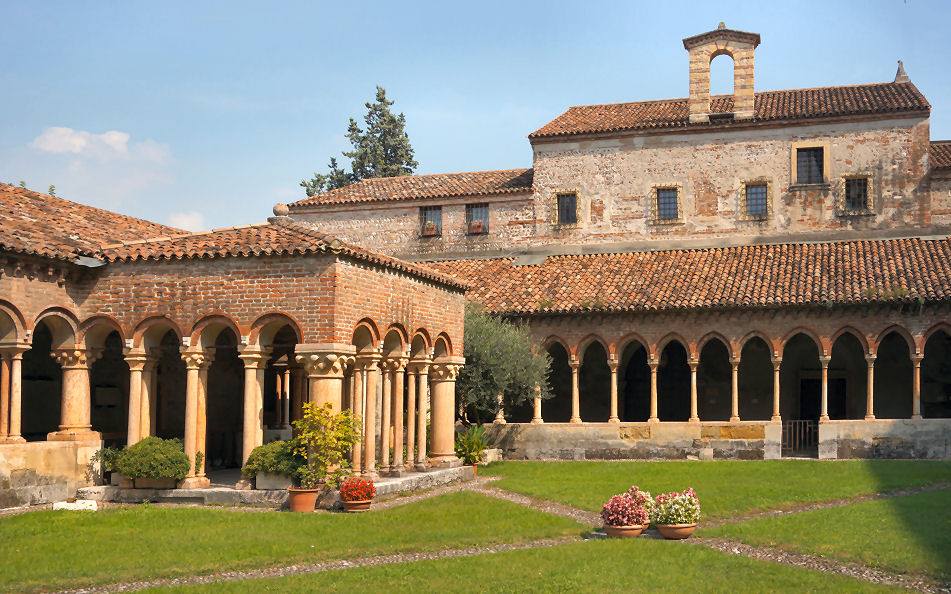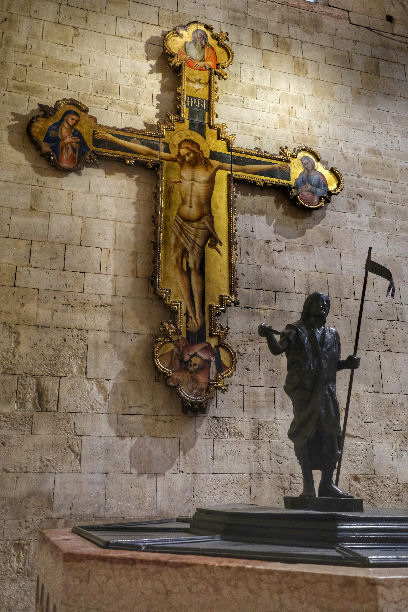|
|
|
History The first small church was erected nearby in the 4th/5th century by the Ostrogoth king Theodoric, presumably around Saint Zeno's burial place in the cemetery here, which dated from Roman times. A church and Benedictine monastery was then built in the early 9th century, with the help ok Pepin, Kimg of Italy and son of Charlemagne, with consecration in 806 and soon after the translation of the saint's relics into the new church. After being severely damaged by the Magyar invasion of 951, a new Romanesque church was built by Bishop Raterius in 967, with financial help from the Holy Roman Emperor Otto I. This church was damaged on January 3rd 1117 by the earthquake which so affected so many of Verona's churches, and was rebuilt bigger at the city's expense, in 1123-1138, this being the almost-unchanged church we see today, called the Basilica di San Zeno. The church has remained unchanged as a building symbolic of the city's early communal government, which met here for civic as well as religious occasions. The roof and the Gothic-style apse date from 1398. Fašade The cream-coloured facade is the work of sculptor/architect Brioloto with help from sculptor Adamino da San Giorgio, who seems to have especially enjoyed carving animals, which he did below the slanting roof cornices. It is a screen fašade with a Lombard porch and a wall passage. The rose window in the shape of a Wheel of Fortune is 13th-century. The outer grey rim of the window is decorated with six figures representing the trials of human life. The porch and reliefs date to around 1138 and are the work of the sculptor Niccol˛ (aka Nicholaus) along with his assistant Guglielmo - his signature is visible in several places. He also worked on the porches of the duomos in Ferrara and Verona, the latter his last known work. St. John the Baptist and St. John the Evangelist flank the arch with the Lamb and the blessing hand of God in the centre. The polychrome lunette above the door shows St. Zeno stamping on demons and blessing the city's banners. Under the lunette are reliefs of the Miracles of St. Zeno and around is the cycle of the months. The door is flanked by panels of marble reliefs showing scenes from the New Testament on the left (signed by the assistant Guglielmo) and the Old Testament on the right To the left of the fašade is the squat crenellated tower of the old abbey, which was mentioned by Dante in the Canto 18 of Purgatory and which contains 13th century frescoes. Between it and the church is the entrance to the church via the early 14th cloister. A small loggia (see photo below) protrudes on the cloister's north side which once housed a fountain for washing before entering the refectory (the lavatory of the monks, as one guidebook has it). Some of the tombs here have come from suppressed churches. They include those of Giuseppe della Scala and Ubertino della Scala, who was the prior of the adjoining monastery.  Interior Latin cross shaped with striped walls created by layers of brick and stone. The nave is undecorated otherwise, up to the coffered ship's-keel wooden ceiling from the 14th century, a type seen only in the Veneto. The aisle walls have considerable frescoes though, from various periods. Between the nave and aisles are alternating compound piers and columns. There are three levels with a wide staircase down to a large crypt and two smaller ones up to the raised presbytery.  The bronze doors can be admired opened into the church in the doorway. The panels on the left door arguably date from the 12th century, are described as 'German school, and depict scenes from the New Testament. Those on the right are later and by a local artist, and depict scenes from the Old Testament. Thirteen steps lead down from the door. Inside the church in the corner to the right of the doors is a Crucifix by Lorenzo Veneziano (see right, recently - December 2022 - returned from restoration) and an octagonal baptismal font from the 13th century. The first (Renaissance) altar on the right has an altarpiece (1520) by Francesco Torbido depicting the Virgin and Child and Saint Anne with Saints Zeno, James, Sebastian and Christopher. The surrounding fresco work is attributed to Battista del Moro. On the wall just beyond is a patch of frescoes from the 13th to 15th centuries, including a large 14th century Saint Christopher. On the pilaster is the very faint so-called White Madonna, described as 'school of Giotto'. The next altar has odd knotted-effect marble columns retrieved from a Romanesque porch demolished in the 13th century holding up a wooden tympanum. Behind it and up the stairs into the upper church are more frescos of various periods, dominated on the right by a Saint George and the Dragon above The Transportation of Saint Zeno's Relics. The frescos to the left of Saint George, showing The Baptism of Christ and The Raising of Lazarus are amongst the oldest here. Many are embellished with period graffiti which evidently refer to events in the 15th and 16th centuries like floods earthquakes and plagues (see photo right). The Saint George and one of the many depictions of the Virgin Enthroned nearby are given to the so-called Second San Zeno Master. In the apse (see photo below) built by Giovanni and Nicol˛ da Ferrara from 1386 to 1398, the high altar rests on the sarcophagus of Veronese bishops Lupicino and Lucillo and the hermit Crescenzano. The frescoes at the back, from before 1412, which would have been the focus of the church before Mantegna's altarpiece, are by Martino da Verona, as is The Annunciation on the arch around the apse.
The altarpiece (see above) is by Andrea Mantegna (1457-9), known as the
San Zeno Altarpiece.
It was commissioned by the Venetian humanist Abbot Gregorio Correr. It was painted in Padua,
after Mantegna had completed the Ovetari Chapel in the
Ermitani
there, and probably delivered
to Verona in late 1459. It was the first Renaissance painting seen in
Verona, it is said. Despite its saturated colours, which make it look like
it was painted in oils, it was executed entirely in tempera. Foremost among its innovations is how the main
register takes the form of triptych but has a unified space, divided by
framing columns which echo the architecture in the painting. The classical
frame was also, probably, designed by Mantegna. The main panels show The
Virgin and Child Enthroned, with Saints Peter, Paul, John the
Evangelist and Zeno on the left and
Saints John the Baptist, Gregory, Lawrence and Benedict on the
right. San Zeno is thereby just one amongst eight saints depicted, the
choice of which was, it has been suggested, a reflection of their being
the dedicatees of Verona's other churches. The opening up of the window in the right wall of the apse was
reportedly demanded by Mantegna to match the direction of the lighting in
the picture. And the painted architecture within the altarpiece would seem
oddly to suggest the viewer standing in front of the right hand panel. |
|
|
|
|